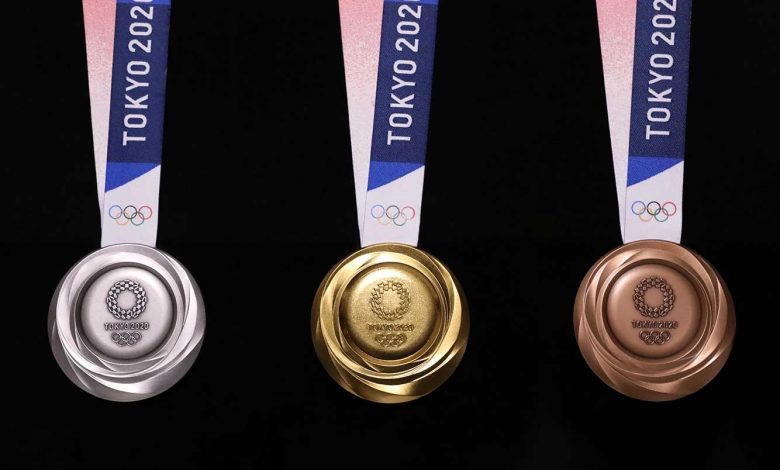The Tokyo 2020 Olympic Medals Made of Recycled Cell Phones
People all over Japan participated in the creation of the Tokyo 2020 Olympic medals.

Beginning on July 24, 2020, people all over the world will gather in front of their TVs, or in Tokyo if they’re lucky, to witness the Tokyo 2020 Olympics. Once the Olympics start up, that’s almost all anyone can talk about. However, this next year, people might be talking about the medals a little more than usual.
The Tokyo Organizing Committee of the Olympic and Paralympic Games for Tokyo 2020 (TOCOG) conducted the “Tokyo 2020 Medal Project” to collect small electronic devices, such as used mobile phones, to produce the Olympic and Paralympic medals. This is not the first Olympic Games with medals made from recycled materials; most recently at Rio 2016, an estimated 30% of the silver and bronze medals originated from recycled materials. However, the Tokyo 2020 medal project is unique in its scale.
In the span of two years, between April 2017 and March 2019, people all over Japan participated in the project. A total of 78,985 tons of mobile phones and other small consumer electronics were collected by municipalities across Japan. Of the 1,741 cities, towns, and villages nationwide, over 90% of those participated.
“We are grateful for everyone’s cooperation to this project,” says the organizing committee. “We hope that our project to recycle small consumer electronics and our efforts to contribute to an environmentally friendly and sustainable society will become a legacy of the Tokyo 2020 Games.” With a theme for the Olympics that says, “Be better, together – for the planet and for the people,” TOCOG’s intention is to make the Tokyo 2020 Olympics the most environmentally friendly and sustainable Games so far.
The donated devices were classified and dismantled by contractors accredited in line with the government’s Act on Promotion of Recycling of Small Waste Electrical and Electronic Equipment. The medals were produced after the gold, silver, and bronze elements were extracted by the smelting contractors. Approximately 32kg of gold, 3,500kg of silver, and 2,200 kg of bronze were extracted.
All of the metal extracted from the small electronic devices was used to make approximately 5,000 gold, silver, and bronze medals. What that equates to is every single medal to be awarded to the athletes during the Tokyo 2020 Games is made from recycled materials.
To come up with a design for the sustainable medals and to further involve the public, Tokyo 2020 launched a medal design competition, inviting professional designers and design students to submit designs for the medals. “From the procurement of the metals to the development of the medal design, the entire country of Japan was involved in the production of the medals for the Tokyo 2020 Games – truly a project that was possible with the participation of everyone across Japan,” the Tokyo 2020 website explains.
With over 400 entries for the medal design, Junichi Kawanishi, director of the Japan Sign Design Association and the Osaka Design Society, was awarded the design opportunity. The frontside of Kawanishi’s design showcases the Tokyo Olympic Emblem, with Nike the Greek goddess of victory on the backside. The ribbon design features traditional Japanese design motifs. The design of the medals aims to reflect the themes of light, brilliance, diversity, hard work, and friendship.
According to the “How it’s Made” video (see link below), the medals resemble rough stones that have been polished and now shine. “The medals carry everyone’s hope that is delivered to athletes from all over the world,” says the organizing committee for Tokyo 2020.
“As a committed recycler both at home and at work, I was very excited to see The Tokyo Organizing Committee of the Olympic and Paralympic Games (Tokyo 2020) make the commitment to have all 5,000 Olympic medals made from recycled metal,” remarks Bob Hagel, owner of Eagle’s Mark Awards and Signs. “I hope the Japanese start a trend in the awards industry to use recycled materials for metal, plastic, and glass awards.”
Hagel further elaborates on the recycled medals: “I have been asked to supply awards made from recycled materials several times. I found it difficult to find a supply. Perhaps with a few other significant international awards being made from recycled materials, a real trend will start that is sustainable. As the Olympics begin in 2020, perhaps the recycled metal Olympic medals will get a lot of publicity and attention.”
While there are several manufacterers and distributors that sell awards made from recycled materials, this is not an entirely new concept. Another recent example is medal and trophies made from plastic waste for the University Athletic Association of the Philippines. This project, done with JunkNot Eco Creatives, saved approximately 340 kilos of plastic waste and 265 kilos of scrap metal such as bullet shells, door knobs, and pipes. Sustainable materials like bamboo and reclaimed wood were also used. These medals and trophies were handcrafted by an Infugao artisan and assembled by a community in Taal and Marawi.
Other sustainability initiatives for the Tokyo 2020 Games include uniforms for the Olympic Torch Relay produced in part using recycled plastic bottles, and victory ceremony podiums will be made from recycled household and marine plastic waste. The Japanese public also contributed around 45 tons of household plastic to create 100 podiums for the Games.
Watch this video to see how the medals were created. For more information on the medals, visit tokyo2020.org/medals.